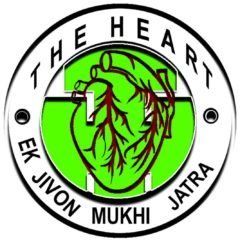Category: Articles
CARDIOVASCULAR DISEASE (CVD)
The term ‘cardiovascular disease’ (CVD) refers to any disease of the heart, vascular disease of the brain, or disease of the blood vessel. Created by the World Heart Federation(WHF), World Heart Day informs people around the globe that CVD, including heart disease and stroke, is the world’s leading cause of death, and highlights the actions that individuals can take to prevent and control CVD. It aims to drive action to educate people that by controlling risk factors such as tobacco use, unhealthy diet and physical inactivity, at least 80% of premature deaths from heart disease and stroke could be avoided. More people die from CVDs worldwide than from any other cause: over 17.9 million every year, according to the World Health Organization. Of these deaths, 80% are due to coronary heart diseases (e.g heart attack) and cerebrovascular diseases (e.g strokes) and mostly affect low- and middle-income countries. Continue reading “CARDIOVASCULAR DISEASE (CVD)”
Look After Your Heart
Make a promise to your heart. A promise to eat more healthily,
By making just a few small changes to our lives, we can all live longer, better, more heart-healthy lives
So this World Heart Day, it’s your opportunity to make a promise … a promise to cook and eat more healthily, to do more exercise and encourage your children to be more active, to say no to smoking and help your loved ones to stop.
A simple promise … for MY HEART, for YOUR HEART, for ALL OUR HEARTS.
Promise to eat well and drink wisely
- Cut down on sugary beverages and fruit juices – choose water or unsweetened juices instead
- Swap sweet, sugary treats for fresh fruit as a healthy alternative
- Try to eat 5 portions (about a handful each) of fruit and veg a day – they can be fresh, frozen, tinned or dried
- Keep the amount of alcohol you drink within recommended guidelines
- Try to limit processed and prepackaged foods that are often high in salt, sugar and fat
- Make your own healthy school or work lunches at home
Promise to get more active
- Aim for at least 30 minutes of moderate-intensity physical activity 5 times a week
- Or at least 75 minutes spread throughout the week of vigorous-intensity activity
- Playing, walking, housework, dancing – they all count!
- Be more active every day – take the stairs, walk or cycle instead of driving
- Exercise with friends and family – you’ll be more motivated and it’s more fun!
- Download an exercise app or use a pedometer to keep track of your progress
Promise to say no to smoking
- It’s the single best thing you do to improve your heart health
- Within 2 years of quitting, the risk of coronary heart disease is substantially reduced
- Within 15 years the risk of CVD returns to that of a non-smoker
- Exposure to secondhand smoke is also a cause of heart disease in non-smokers
- So by quitting (or not starting in the first place), you’ll not only improve your health but that of those around you
- If you’re having trouble stopping, ask for professional advice and ask your employer if they provide smoking-cessation services
THE WORLD HEART DAY CELEBRATION 29TH SEPT, 2019
Dear friends let us walk on 29th September 2019, Sunday morning at 6 AM for health education and awareness from Dispur Hospital, Ganeshguri. Our aim is to give a reminder to all to make a promise for my heart, for your heart and for all our hearts to
- Promise to our families to cook and eat healthy
- Promise to our children to exercise more and become more active
- Promise to say no to smoking and help our loved ones to quit smoking
KNOW ABOUT YOUR HEART – ARE YOU REALLY HEALTHY?
HEART DISEASE CAN BE VERY SILENT IN THE BEGINNING. SO KNOWING ABOUT OUR OWN HEART IS A MUST TO GET RID OF SERIOUS HEART DISEASES AND TO TAKE PROMPT TREATMENT IF IT IS DETECTED. SO IT IS OF UTMOST IMPORTANCE TO KNOW ABOUT THE PROVEN RISK FACTORS AND TO MODIFY THE FACTORS WHEREVER POSSIBLE.
MAIN RISK FACTORS OF HEART DISEASES ARE EASILY DETECTABLE EVEN BY A LEHMAN: e.g.
- HIGH BLOOD PRESSURE
- DIABETES MELLITUS
- HIGH CHOLESTEROL
- HABITS LIKE SMOKING
- TOBACCO CHEWING etc.
- AGE
- FAMILY HISTORY OF HEART DISEASE.
MAJOR SYMPTOMS ARE:
- EXERCISE RELATED CHEST PAIN OR HEAVINESS
- BURNING CHEST DISCOMFORT
- JAW PAIN
- DIFFICULTY IN BREATHING
- LOSS OF CONSCIOUSNESS
- LEG SWELLING
- PALPITATION ETC.
HOW TO DETECT HEART PROBLEMS:
- CONSULT A CARDIOLOGIST
- GO FOR SIMPLE TESTS LIKE ECG, ECHOCARDIOGRAPHY, TREADMILL TEST (TMT), 24 HOURS HOLTER MONITORING AS ADVISED BY YOUR DOCTOR.
- IF NECESSARY SOME SPECIAL TESTS ARE ADVISED BY CARDIOLOGISTS LIKE CORONARY ANGIOGRAM, CT CORONARY ANGIO, CARDIAC MRI, SPECT-THALLIUM ETC.
হৃদৰোগ – এক নীৰৱ ঘাতক
হৃদৰোগ প্ৰতিৰোধ কৰো আহক
ডাঃ চন্দন মোদক
হৃদযন্ত্ৰৰ কাম কি?
হৃদযন্ত্ৰ আমাৰ শৰীৰৰ মূখ্য অংগ যিয়ে আমাৰ অন্যান্ন সকলো অংগ-প্ৰত্যংগৰ সঠিক পৰিচালনাৰ কাৰণে অতি জৰুৰী অম্লজান(OXYGEN)ৰ যোগান ধৰে। আমি নজনাকৈয়ে আমাৰ জন্মৰ আগৰে পৰাই আমাৰ হৃদপিন্ডই ইয়াৰ সংকোচন সম্প্ৰসাৰনৰ জৰিয়তে অবিৰতভাৱে আমাৰ সমস্ত শৰীৰলৈ ৰক্তসন্চালন প্ৰক্ৰিয়া চলাই ৰাখে- আমাৰ মৃত্যুলৈকে ।
হৃদৰোগ কি ?
হৃদৰোগ হ’ল একাধিক ৰোগৰ সমষ্টি যিবোৰে আমাৰ হৃদযন্ত্ৰক আক্ৰমণ কৰি ইয়াৰ সঠিক কৰ্মপ্ৰক্ৰিয়াত ব্যঘাত জন্মায়। যেনে-
- ‘ৰিউমেটিক হাৰ্ট ডিজিজ’ ( Rheumatic Valvular Heart Disease) অথবা ভাল্ভৰ বেমাৰ,
- ‘কোৰোনাৰী আৰটাৰী ডিজিজ'(Coronary Artery Disease) অথবা হৃদযন্ত্ৰৰ তেজৰ নলীকাৰ বেমাৰ,
- ‘হাৰ্ট এটেক’ (Heart Attack),
- হাৰ্ট ফেইলাৰ’ (Heart Failure),
- হাৰ্ট ব্লক’ (Heart Block)
‘ৰিউমেটিক হাৰ্ট ডিজিজ’ – ভাল্ভৰ বেমাৰ
- এবিধ বেক্টেৰিয়াৰ আক্ৰমণৰ ফলত হৃদযন্ত্ৰৰ ভাল্ভ ক্ষতিগ্ৰস্ত হয় আৰু আমি হৃদৰোগত আক্ৰান্ত হৈ পৰো।
- বেছিভাগ ৰোগীৰ ক্ষেত্ৰতে শ্বাস-প্ৰস্বাসৰ কষ্ট, অনবৰত বুকুৰ ধপধপনি, কাঁহ, ভৰি ফুলা ইত্যাদি লক্ষ্যণবোৰে দেখা দিয়ে।
- এই ৰোগ আমাৰ দুখীয়া শ্ৰেণীৰ মানুহৰ মাজতে বেছিকে দেখিবলে পোৱা যায়।
- এই ৰোগৰ পৰা হাত সৰাৰ একমাত্ৰ উপায় হৈছে্ সাধাৰণ কাঁহ জ্বৰ হ’লেও ডাক্তৰৰ পৰামৰ্শ লৈ এন্টিবায়টিক খোৱা যাতে বীজাণুবিধে হৃদযন্ত্ৰক আক্ৰাণ্ত কৰিব নোৱাৰে।
‘কোৰোনাৰী আৰটাৰী ডিজিজ’ অথবা হৃদযন্ত্ৰৰ তেজৰ নলীকাৰ বেমাৰ
- তেজৰ নলীকা কিছুমানে হৃদপিন্ডৰ পেশীক অম্লজান আৰু খাদ্যৰ যোগান ধৰে।
- আমাৰ শৰী্ৰৰ ক্ষতিকাৰক মেদৰ (CHOLESTEROL) পৰিমাণ বাঢ়িলে তেজৰ নলীকাবোৰত এই মেদ জমা হয় (ATHEROSCLEROSIS) আৰু নলীবো্ৰ ব্যাসাৰ্ধ কমি যায়।
- এই নলীবো্ৰ যদি আংশিকভাৱে বন্ধ হয় তেতিয়া মানুহৰ বুকুৰ বিষ (ANGINA) হয়।কামৰ লগত, খোজৰ লগত এই বিষ বাঢ়ি যায় আৰু আৰাম কৰিলে কমি যায়।
‘হাৰ্ট এটেক’ (Heart Attack)
- এই নলীবো্ৰ যদি সম্পূৰ্ণৰূপে বন্ধ হয় তেতিয়া বহুত গুৰুতৰ বেমাৰ- ‘হাৰ্ট এটেক’ হোৱা বুলি কোৱা হয়।
- বেছিভাগ ৰোগীৰ ক্ষেত্ৰতে প্ৰচন্ড বুকুৰ বিষ হয়, বাঁও হাতৰ বিষ, বুকুত হেচা মাৰি ধৰে, ঘামি যায়, মৰি যোৱাৰ ভয় হয়।
- শ্বাস-প্ৰস্বাসৰ কষ্ট, বুকুৰ ধপধপনি ইত্যাদি লক্ষ্যণবোৰে দেখা দিয়ে।
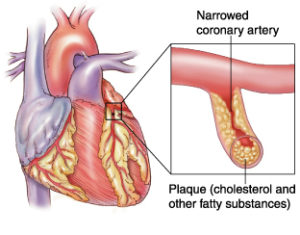
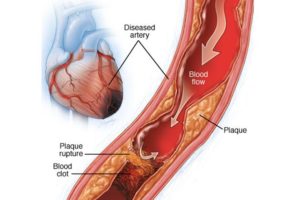

‘হাৰ্ট ফেইলাৰ’ -Heart Failure
হৃদযন্ত্ৰৰ পেশীৰ দুৰ্বলতাৰ ফলত ইয়াৰ সংকোচন শক্তি হ্ৰাস পায়।
লক্ষ্যণসমূহ:
- দুৰ্বলতা, খোজ কাঢ়িলে শ্বাস-প্ৰস্বাসৰ কষ্ট,
- ভৰি ফুলা, পেট ফুলা,
- শ্বাস-প্ৰস্বাসৰ কষ্টত ৰাতি শুব নোৱাৰা হোৱা,
- ৰাতি কাঁহি থকা
- বুকুৰ ধপধপনি
‘হাৰ্ট ব্লক’ (Heart Block)
হৃদযন্ত্ৰৰ গতি হ্ৰাস পালে মানুহ মুৰ্ছা যায়।
লক্ষ্যণসমূহ:
- ভাল মানুহ এজন হঠাতে মুৰ্ছা যোৱা,
- হঠাতে মূৰটো বেয়া লগা আৰু পৰি যোৱাৰ উপক্ৰম হোৱা,
- দুৰ্বলতা,
- ভৰি ফুলা
হৃদৰোগৰ পৰা হাতসৰাৰ উপায় আছেনে?
- আছে।।
- উচ্চ ৰক্ত চাপ নিয়ন্ত্ৰণ কৰক–প্ৰতিদিনে দৰৱ খাওক, নিৰ্দিষ্ট সময়ৰ মূৰে মূৰে ডাক্তৰৰ পৰামৰ্শ লওক ।
- ডায়েবেটিছ দূৰাৰোগ্য ব্যধি-ইয়াক নিয়ন্ত্ৰণ কৰক, প্ৰতিদিনে দৰৱ খাওক, নিৰ্দিষ্ট সময়ৰ মূৰে মূৰে ডাক্তৰৰ পৰামৰ্শ লওক ।
- জীৱন শৈলী উন্নত কৰক–নিতৌ অন্ততঃ ৪৫ মিনিট সময় শৰীৰ চৰ্চা কৰক- দৌৰক, চাইকেল চলাওক বা সাতোৰক ।
- তেলুক মাংস, গাখীৰৰ মাখন, ঘী, কনীৰ কুহুম আদি হৃদৰোগৰ শত্ৰু-আজিয়ে বৰ্জন কৰক ।
- সতেজ সেউজীয়া শাক-পাচলি, ফল-মূল বেছিকৈ খাওক।




PERIPHERAL ARTERIAL DISEASE (PAD)
Dr Chandan Modak
Peripheral arterial disease is a disorder of the blood vessels outside the brain and heart. Heart attack is due to the blockage of the blood vessels supplying the heart. Similarly leg attack, intestinal attack can happen when the blood vessels to these organs are blocked. The basic mechanism is similar to that of coronary artery disease with most common cause is atherosclerosis which means there is deposition of bad cholesterol inside the blood vessel wall leading to narrowing of the lumen of the vessel.
Peripheral arterial disease is narrowing of the blood vessels to the legs and arms.When there is a reduced blood supply to the leg, this causes thigh and calf muscle pain while walking. Pain disappears during rest.
RISK FACTORS:
- DIABETES
- HIGH BLOOD PRESSURE
- HIGH CHOLESTEROL
- SMOKING
- OBESITY
- OLD AGE GROUP
- A FAMILY HISTORY OF PAD, CORONARY ARTERY DISEASE OR STROKE
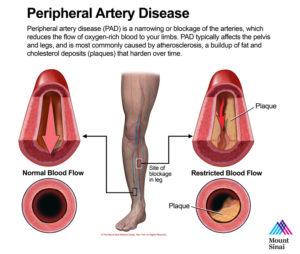
SYMPTOMS
- Cramping or fatigue in the legs while walking
- Non-healing ulcers on the feet or legs
- Pain in the feet while on bed
- Numbness and tingling
- Coldness in lower leg or foot
- A change in colour of legs
- Shiny skin on legs
- Loss of hair over legs
- Late presentation is critical limb ischemia and necrosis of the limb which may require amputation(surgical removal of the part from body)
TREATMENT
- Even some patients with severely low blood flow causing gangrene (necrosis) may have their toes or limbs saved by interventional cardiologist by nonsurgical treatments like balloon angioplasty, stent placement through percutaneous procedures.
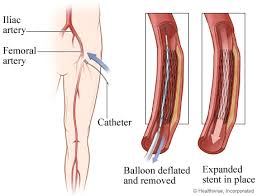
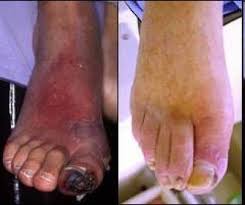
When to worry about a fever in adults
Dr Chandan Modak
What is a fever? — A fever is a rise in body temperature that goes above a certain level. The level that is considered a fever depends on how you take the temperature. Here are the values that are considered a fever:
●Oral (mouth) temperature above 100ºF (37.8ºC)
●Armpit temperature above 99ºF (37.2ºC)
●Ear temperature above 100.4ºF (38ºC) in rectal mode or 99.5ºF (37.5ºC) in oral mode
●Forehead temperature above 100.4ºF (38ºC)
●Rectal temperature above 100.4ºF (38ºC)
What is the best way to take my temperature? — Armpit, ear, and forehead temperatures are easier to measure than rectal or oral temperatures, but they are not as accurate.
Here is the right way to take an oral temperature:
●Wait at least 30 minutes after you eat or drink anything hot or cold.
●Wash the thermometer with cool water and soap. Then rinse it.
●Place the tip of the thermometer under your tongue toward the back. Hold the thermometer with your lips, not your teeth.
●Keep your lips closed around the thermometer. A glass thermometer takes about 3 minutes to work. Most digital thermometers take less than 1 minute.
The height of the temperature is less important than how sick you feel. If you think you have a fever and you feel sick, your doctor or nurse might want you to double-check by getting an oral or rectal temperature.
What causes fever? — The most common cause of fever in adults is infection. Common infections that can cause fever include:
●A cold or the flu
●An airway infection, such as bronchitis
●A stomach bug
Most of these infections are not serious and get better on their own.
When should I see a doctor or nurse? — Call your doctor or nurse if you get a fever and you:
●Are pregnant
●Recently got back from a trip to Africa, Asia, Latin America, or the Middle East
●Just got out of the hospital, or had surgery or another medical procedure
●Get infections often
●Are on chemotherapy – Call your doctor or nurse if your oral temperature goes above 100ºF (37.8ºC) for more than one hour. Also call if it goes above 101ºF (38.3ºC) even just one time.
●Take medicines that suppress the body’s infection fighting system, also called the “immune system” – Examples of these medicines include steroids and medicines used to prevent rejection after organ transplant.
You should also call if you have:
●Fever that lasts several days or keeps coming back
●A recent bite from an insect called a tick – Infections you can catch from tick bites can cause fever and other symptoms.
●A serious health condition, such as diabetes, heart disease, cancer, lupus, or sickle cell anemia
●Fever plus one or more of these symptoms:
•Rash
•Trouble breathing
•Severe headache or neck pain
•Seizure or confusion
•Severe vomiting or diarrhea
•Severe pain in the belly, back, or sides
•Any other symptom that is unusual or worries you
Will I need tests? — Maybe. Your doctor or nurse will do an exam and talk with you about your symptoms. You might also have the following tests:
●Blood tests
●Urine tests
●Chest X-ray or CT scan – These imaging tests create pictures of the inside of the body.
Your doctor or nurse will talk to you about any other tests you might need.
Can I do anything on my own to feel better? — Yes. You can stay home, rest, and drink plenty of fluids. You can also take acetaminophen (sample brand name: Tylenol) to relieve fever.
How are fevers treated? — That depends on the cause. Many people do not need treatment. If you do, treatments can include:
●Antibiotics to fight the infection. But antibiotics only work on infections caused by bacteria, not infections caused by viruses. For example, antibiotics will NOT work on a cold.
●Medicines, such as acetaminophen or ibuprofen. These medicines can help bring down a fever. But they are not always necessary.
Asanas for Mom Aspirant Working Women
Dr. Ramala Sarma
Assistant Professor
Department of Philosophy
Nowgong College: Nagaon
Age matters in whatever we do, whatever episode of our life we pass through. Be it getting admitted in an academic institute, applying for a job, getting married or having a child, age is the first and foremost condition. For age indicates different states of body and mind.
Indeed, age tells us when is the best time for the human body to perform a particular action. And acting in the right time helps you reap the best fruit of your action, while failing to do it may leave you in utter hopelessness. For some chances, unlike seasons, are not repetitive. Moreover, we cannot reverse our age!
Thus aging has often been a challenge for every man and woman. It is a process we lose our potentiality through. Particularly for the working woman, aging comes as a warning. For she has to achieve two important milestones of her life— one is attaining her femininity in the fullest sense of the term and the other is reaching the pinnacle of her career height. Both often require her to strive for in sync. As a result, success in one quite often leaves a negative impact on the other.
It is not a rare case when a woman professional gets to hear from her physical consultant that her uterus is not working well due to aging. It is probably the worst verdict from the physician to any mom aspirant who is likely to suffer the loss for no fault of hers.

However, every challenge has its own way out. A working woman can achieve both her goals with a little care and a bodily discipline as well. Well, she cannot stop aging, but she can keep her body healthy so it can withstand the cruelty of aging. A good food habit coupled with regular practice of yogasana and pranayama could be handy for her.
Of the many asanas, Bhujangasana and Salabhasana are the two that help keep the uterus healthy. The steps of these asnas along with other benefits that they offer are given below—
Bhujangasana (snake pose):
Bhujanga is a Sanskrit word for snake. This posture resembles a snake with its hood raised.
Steps: Lie on the chest and stomach. Put the legs together and straight with the toes touching the ground and pointing backward. Now bending the arms at elbow, place the palms on the ground one foot apart from the chest. Then while inhaling, slowly raise neck, chest and then belly with the dignity of a cobra. While exhaling, go back to the original position.
Breathing and duration: Breathe normally and practice it for 15-20 seconds.
Benefits: This asana works as a blessing for the women. It heals uterus-related diseases and cures monthly cycle pain. It replenishes lost energy. It cures acidity, indigestion and waist pain. It tones up the reproductive system, the spinal cord, liver, and kidney. This asana is one of the healing asanas for high blood pressure patients.
Salabhasana (locust pose):
Steps: Lie on the chest keeping the legs straight behind. Place the palms under thighs facing downward. Rest the chin on the ground. Now raise the legs up about 45 degree from the ground without bending at the knees. Put the legs together while lifting. After a few seconds, lower them without bending at the knees.
Breathing and duration: Breathe normally and practice it for 10-15 seconds.
Benefits: Aside keeping uterus healthy, this asana also keeps abdomen, stomach, liver, pancreas and brain well working. It tones up chest and neck. It strengthens vertebral column by supplying abundant blood to it. It heals leg pain and sciatica, lumbar spondylitis and slipped disk etc.
We cannot alter the law of nature. What we can do is to go in harmony with it. Technological breakthroughs have done wonders to our life, but those are external aids. Moreover, they come at a high price unaffordable by many. Yoga— a time-tested practice— comes free to everyone. What it costs only is regularity.
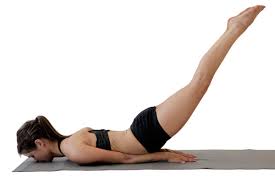
Diets That Help To Fight Or Prevent Cancer.
Staying active, making healthy food choices and
avoiding known risk factors can reduce your risk of getting cancer.
Dr B C Roy
Smoking & Tobacco
Tobacco use is responsible for at least 30% of all cancer deaths. Smoking causes almost 90% of all lung cancers. People who live with smokers are more likely to develop lung cancer and even limited exposure to secondhand smoke can raise your heart disease risk.
Smoking causes 85% of all lung cancers. If you smoke, even occasionally, quit smoking. The health benefits of quitting starts instantly after you stop smoking.
If you live with a smoker or you are regularly exposed to secondhand smoke, you are more likely to develop lung cancer. Even limited exposure to smoke can raise your heart disease risk.
Other Nicotine Products
Cigars, pipes and hookahs are not safe alternatives to smoking. In fact, hookah users may inhale more smoke than cigarette smokers, because hookah sessions often last an hour or more.
Smokeless tobacco products like chewing tobacco and snuff can cause mouth and throat cancers. Snuff may increase your risk for cancers of the mouth, esophagus, stomach and pancreas.
E-cigarettes are smokeless devices that vaporize a solution of nicotine, flavoring and other chemicals. E-cigarettes are not a safe alternative to smoking. Their ingredients are unregulated, and there is no evidence they are effective as a smoking cessation tool. While they do not contain tobacco, the nicotine they contain is highly addictive and harmful.
Taking the right food can prevent cancer.
Chances of developing cancer and chronic diseases can be reduced by making healthier food choices. A diet rich in plant foods like whole grains and legumes can give our body the range of vitamins, minerals and antioxidants it needs to stay healthy. And also, eating a variety of healthy foods can help prevent weight gain and decrease body fat.
Fill your plate with 2/3 or more of vegetables, fruits, whole grains or beans and 1/3 or less of lean animal protein. The AICR also recommends the following nutrition-related actions to reduce your cancer risk:
Avoid sugary drinks and limit consumption of energy-dense or high-calorie foods.
Limit consumption of red meats to 18 ounces of cooked meat per week. Red meat includes beef, pork and lamb.
Avoid processed meats like ham, bacon, sausage, hot dogs and deli meat.
Limit alcoholic drinks to 2 for men and 1 for women a day.
Limit consumption of added salt, salty foods and foods processed with salt (sodium).
Don’t use supplements to protect against cancer
Physical Activity
Living an active lifestyle can help prevent obesity, which is a major risk factor for cancer.
By increasing your physical activity, you lower your risk of many types of cancers including breast, endometrial, prostate, colorectal and lung cancers. Aim for at least 150 minutes of moderate exercise each week or 75 minutes of more vigorous exercise each week. Examples of moderate activities include walking, yoga and mowing the lawn. Examples of vigorous activity include running or jogging, fast bicycling and swimming. In addition, sit for less time each day. Sitting too much increases body fat, which leads to cancer and other chronic diseases. Try to get up and move for one to two minutes every hour that you are awake.
Do muscle strengthening exercises at least twice a week. Strength training helps you maintain a healthy weight because the more muscle you have, the higher your metabolism.
Skin Safety
Limiting your exposure to the sun goes a long way in preventing skin cancer and melanoma.
Skin cancer is most common cancer in the western countries. But it’s the most preventable cancers. The primary cause is too much exposure to sun. People of all skin colors can develop skin cancer. It’s the easiest cancers to detect. Most of its types are highly curable too.
Risk factors for skin cancer include:
Frequent or intense sun exposure
One or more blistering sunburns
Red or blond hair, fair skin, freckles and blue or light-colored eyes
More than 50 moles
A family history of melanoma
A personal history of melanoma
A personal history of basal cell or squamous cell skin cancers
HPV
The human papillomavirus is a risk factor for several types of cancer. However, getting an HPV vaccination for your children can reduce their cancer risk. About 80% of people –both men and women – will get a human papillomavirus (HPV) infection at some point in their lives. HPV is spread by intimate skin-to-skin contact. While most cases are sexually transmitted, people who haven’t had intercourse can become infected.
There are many strains of human papillomavirus (HPV). Several types are linked to cancer. Most people with HPV don’t know they’re infected and never develop symptoms or health problems from it.
The body usually clears HPV on its own. When it remains, it can lead to health problems such as genital warts and several types of cancer, including:
Cervical cancer
Penile cancer
Anal cancer
Oropharyngeal cancer
Screening tests can determine if a woman has HPV. There is no screening exam to detect HPV or HPV-related cancers in men, and there are no treatments for the virus itself. However, there are ways to treat HPV-related health problems, such as precancerous lesions and genital warts.
About the HPV Vaccine:
HPV vaccines that are used—–
Cervarix (HPV 2) and Gardasil (HPV 4) protect against the most common HPV types and against cervical, anal, vulvar, vaginal, penile and oropharyngeal cancers. Only Gardasil protects against the HPV types most likely to cause genital warts. These vaccines prevent about 70% of cervical cancers.
Gardasil 9 (HPV 9) protects against nine types of HPV, including five that other vaccines don’t cover. It also prevents about 90% of cervical cancers.
The vaccines are available for males and females ages 9 to 26. Girls and boys shouid receive the vaccine around age 11 to 12 years.. HPV vaccines are given in a series of three shots over six months. Your child must complete the three-shot series for maximum protection from cancer.
Things to know about the HPV vaccine
The HPV vaccine is a safe and effective vaccination against cancer.
No research links the HPV vaccine to earlier or increased sexual activity in boys or girls.
Becoming pregnant after receiving the HPV vaccine is safe for both mother and fetus.
HPV and cervical cancer
Because no vaccine prevents all types of HPV that can cause cervical cancer, vaccinated women age 21 to 29 should still receive Pap tests every three years.
In addition to Pap tests, women age 30 to 64 also should be tested for HPV every five years. This exam checks your cervix for the virus that can cause abnormal cells that lead to cervical cancer. It may show that more frequent screening is needed.
Women age 65 or older should discuss their individual need for screening with their doctor.
Foods that can reduce your cancer risk
Harvest
Sweet potatoes
Broccoli
Cauliflower
Spinach (preferably organic)
Kale or collard greens (preferably organic)
Peas (fresh or frozen)
lettuce
Tomatoes (no salt added if canned)
Garlic
Pears
Oranges
Red or purple grapes (preferably organic, if imported)
Fresh or frozen berries (preferably organic)
Protein
Lean chicken
Lean fish such as salmon, halibut, redfish or red snapper
Tofu
Black, red or pinto beans (low sodium)
Garbanzo beans/chickpeas (low sodium)
Dairy
Skim milk
Low-fat cheese
Eggs or egg substitutes
Grains
Wild rice or brown rice (regular or instant)
Whole grain pasta
Lentils
Bread
Whole grain bread, tortillas or bunCereal
Bran flakes
Oatmeal
Snacks
Popcorn
Whole grain tortilla chips or crackers
Almonds (plain, unsalted)
Condiments
Olive oil
Canola oil
Low-fat or fat-free salad dressing
Spices
Turmeric
Beverages
Purple grape juice (100% juice, no added sugar)
Green or white tea (tea bags or loose)
Water
